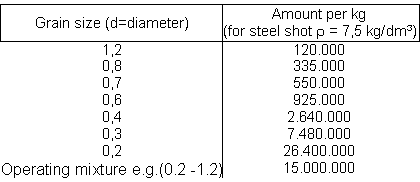|
Whereas the type of the abrasive used to follow clearly from the term “sand
blasting”, nowadays difference has to be made between different kinds
of abrasives. The silica sand that was used in former times can be applied
now only with special permit due to the risk of silicosis; these special
permits have to be applied for at the competent authorities. Silicosis is
a disease (also called black lung) caused by finest silica sand entering
the lung and there it clogs the air sacs.
By using the blasting method various kinds of work can be performed now.
The number of abrasives that can be adjusted to the respective purpose of
work is therefore high. There is no universal abrasive. The selection of
the respective grain sizes is decisive besides the selection of the abrasive.
Bigger particles transfer higher kinetic energy and are thus well suited
to e.g. break open thick layers. Quicker and steadier cleaning results are,
however, obtained by a big number of smaller particles.
Slag, corundum, steel shot and glass have proven to be suitable apart from
some very special abrasives.
3.1 Slag abrasives
In principal, slag abrasive can be used wherever people used to work with
silica sand. Retrofitting of the existing facilities is not necessary. Because
slag abrasive will shatter into particulate matter by 50% an application
with subsequent processing requires much work. Due to the related high percentage
of particulate matter any workplace outside has to be covered.
3.2 Corundum
Corundum is considered to be the most important synthetic abrasive and does
not contain iron. It consists, among other things, of aluminium oxide and
silicon dioxide. Silicic acid only exists in bounded form. Because it can
be produced with different Al2O3–contents – by this the hardness
can be varied – it can be used for different kinds of work. Furthermore,
corundum is supplied in various qualities. Difference is made between an
inexpensive regenerate, electro corundum and expensive high grade corundum.
Corundum can be used for recycling uses. Due to its hardness normal corundum
of medium quality can be used about 20 – 25 times in rotation. This
reduces the necessary amount of abrasives to about 1/20 compared to slag
abrasives. Also after several runs the angular corundum does not lose its
shape. Due to its geometry it is not suitable for applications in shot-blasting
wheels.
3.3 Metallic abrasives
In case of stationary blasting metallic abrasives like steel shot are very
important because they can be processed and the operational costs can be
therefore kept at a low level. The abrasive is made by granulating molten
metal with a water or vapour jet. Metallic abrasives can also be supplied
at different levels of hardness. Hard cast iron shows the biggest hardness
and abrasivity, but it is also the brashest abrasive with a respectively
short durability.
Metallic abrasive can be used about 100 up to 200 times at compressed-air
blasting before it will decompose into particulate matter. The fact that
the kinetic energy is focussed on one point during the impact leads to high
blasting performances. The application of ball-shaped abrasive is necessary
when used in shot-blasting wheels because of high degree of wear and tear.
Wire cuts can also be used as an alternative to steel shot and white cast
iron granular material. This is cut wire having a cylindrical grain shape.
Steel wire has got a very long durability. But as it is considerably more
expensive and it does not round off as quickly as cast steel it has not yet
gained acceptance. The market share amounts to about 15%.
3.4 Glass abrasive
Glass abrasive is free of silicosis and thus harmless. It mainly consists
of bound silicon dioxide. Angular glass convinces by good abrasive performances,
it, however, breaks up quite quickly. Due to high prices glass abrasives
are only used where another abrasive cannot be applied due to its chemical
composition or mechanical properties.
The application of glass beads is more important which are obtained from
molten mass. This ball-shaped material is available at various diameters
up to 0.63 mm. Because of the low grain mass glass beads are suitable for
surface finishing or cleaning processes. Shot peening can be carried out
by this as well.
4. Efficiency assessment of abrasive blasting
An efficiency assessment of all blasting methods with abrasives can be made
through the generated kinetic energy EK and its output at the impact on the
surface.
In order to accelerate the body and to keep it going at a possibly high
speed work has to be performed. This one then exists in the form of kinetic
energy in the body.
If
Ek = kinetic energy of the body (Nm or Joule)
m = mass of the body (kg)
v = velocity of the body (m/s)
then applies

This shows that
the change of the mass has linear and
the change of the velocity quadratic effects.
The kinetic energy of the abrasive increases linearly at the same speed
at increasing mass.
The kinetic energy of the abrasive increases squarely at the same mass at
increasing velocity.
Influence of the grain size of the abrasive on the blasting result
By reducing the medium grain size the number of grains increases exponentially.

“Maximum coverage is achieved with fine abrasive grain.”
“Maximum roughness height is achieved with rough abrasive grain.”
Coverage is a measure for the impacts per mm2.
The abrasive weight thrown off (M) per unit time

The medium grain weight (m)

Result:
If the diameter of the grain doubles
then
the weight of the grain will increase by eight times
the kinetic energy will increase by eight times
the coverage will reduce to one eighth.
|



